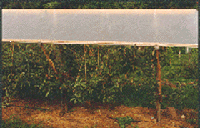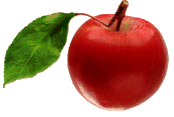
Problems
Problems, Diseases and Sheltering Trees
In South Coastal B.C. apple growers face four big problems:
1..Scab
Scab is caused by a commonly occurring fungus. The fungus germinates and multiplies in cool wet springtime weather and the lesions (damage) are seen as olive-green patches on the leaves and black scabby patches on the fruit.
Scab infections occurring over a number of years weaken the tree and reduce the number and size of the apples.
The Home Gardener can put either plastic or stocking bags on his/her apples, shelter the whole tree, or shelter the whole row of apple trees! (see bottom of page).
Scab on an apple is a cosmetic problem and eating an apple covered with scab is not injurious to your health.
Pictures from BC Ministry of Agriculture
2. Anthracnose Canker
Anthracnose canker is caused by another fungus which germinates and multiplies in cool, wet, late summer/early fall weather.
If the lesion is on a branch, it can be cut out and burned, but if the lesion is on the main trunk, the tree is doomed and should be dug up and destroyed. I have not sprayed any fungicides for scab or canker since 1994.
3. Codling Moth
What is that worm in my apple? That’s the larva of the Codling Moth!
What can I do about it?
1) understand the life-cycle. The adult moth flies into your apple tree usually in the upper third of the canopy at dusk
2) interrupt the life-cycle How? With traps, with banding, and/or with plastic or stocking bags.
A lot of this information comes from Orel Vallen, long time member of the West Cascade Fruit Society. Orel has given me permission to use his findings on my web page.
The Codling Moth, Cydia pomonella (Linnaeus), is a difficult pest to control. There may be three or four generations in south coastal B.C.
There are many natural predators of the codling moth: spiders, chickadees, earwigs and ants eat the eggs and the larvae, various parasitic wasps lay their eggs in the larvae of the codling moth.
Phase 1:
-
Take an empty gallon milk bottle, cut two holes in the side starting about 2” above the bottom. Drill 1/8” hole across neck just below the cap and attach a wire with a hook like a coat-hanger.
-
Take another one gallon milk bottle and add one cup of molasses (non-sulphured), two cups apple cider vinegar and one teaspoon of dry yeast. Fill the bottle with warm water. Put the cap on, mix well and let ferment in a warm place for one day. Mix again and fill the traps with about 2” of bait solution.
-
Recap the remaining solution and store in a cool place.
-
Livestock molasses work fine and are cheaper.
-
When the apple trees have just finished blooming, hang the traps in the upper third of the canopy, about three traps per 15’ high apple tree. Do not hang the traps when the trees are in bloom or you will catch honeybees and blue orchard bees. You should be able to reach the traps and take them down for examining and emptying.
-
Some people use commercial wasp traps or one liter plastic pop bottles with holes cut in the side.
-
Keep the traps in place and keep replacing the fluid until you harvest your apples.
-
Keep at least one inch of fluid in the trap at all times.
On the right is Dan Ester's Codling Moth trap.

Phase 2: Burlap banding, corrugated cardboard.
When the first codling moth is seen in the molasses trap, put the burlap bands on the tree.
Take a piece of burlap and fold it about three times to end up with a 5” wide band. Wrap the trunk of the tree in burlap with the opening of the fold facing up. Fasten with a clothes pin.
Once a week undo the burlap band, open it up and destroy the trapped larvae. Replace the burlap. Leave this burlap banding on all season.
Some thoughts:
-
Watch for mosquitos breeding in the fluid.
-
Always pick up and garbage windfall apples. Do not compost apples with evidence of codling moth (’stings’).
-
Thin your apples so none are touching one another
-
Bag your apples when they are very small.
-
If the bag is clear it can be left on until harvesting and even left on after harvesting.
-
If the bag is opaque, take it off about four days before harvesting so the apple has a chance to colour-up.
4. Erratic pollination
Most of the bees which are responsible for pollination do not fly if the temperature is below 12 degrees Centigrade (53°F). Apple pollen is not viable until the temperature is 14 degrees centigrade (57°F). Here in south coastal B.C., the weather is often cool and wet at bloom time.
Sheltering trees
A few years ago I met a Fraser Valley organic apple grower who was looking for funding to cover some of his trees in an experiment to protect the trees against scab. I thought it was a great idea for a small orchard so in February, 1995, my husband built a roof over five adjacent trees in my 21-tree row of M9/Wilmutta Jonagolds (JOG). This was a clear, colourless, 6 mil (vapour barrier) plastic roof only - no sides.
The shelter was put on before the 'silver tip' stage of leaf development.
If we get easterly outflow winds in winter, the winds are quite strong and cold. We left the shelter on the trees in 1995-6, but the winds really were a problem, I thought the whole structure would fly up and over into the adjacent park. So now we take the shelters off in mid-to-late November and put them back on in mid-March (before 'green tip' stage of leaf development).
Pictures of my sheltered trees. The left and middle pictures were taken in winter when the plastic was furled and tied. The right picture is a side view and was taken during the summer with the plastic in place. See also the aerial view on the home page.

I planted my trees with 6' posts beside every tree so when I wanted to shelter the trees my husband had to extend those 6' posts by about 3' and put a ridge pole along the top

This picture shows the scaffold for a whole row of trees. Each row has 23 trees spaced 6' apart so the structure is 140' long and about 8' high sloping to 5' high at dripline of the trees.
If we did it again, we'd make it 10' high and 7' at dripline to make it easier to get under for pruning and picking.

Some form of irrigation is necessary. I used drip emitters in the beginning, but they were not very good in my gravelly soil so I switched to spray emitters which are much better.
The 6 ml plastic comes in rolls which are 10' wide and 100' long. It is used in house-building as vapour barrier and has some anti-UV chemical in it.


